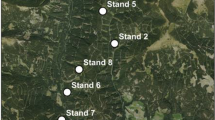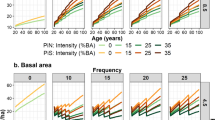Abstract
Large ungulate populations are known to cause economic damage to agriculture and forestry. Bark damage is particularly detrimental to the timber production of certain species, including Picea abies (L.) Karst. (Norway spruce): after bark is wounded, rot often spreads in the trunk base, damaging the most valuable trunk section. Numerous studies have provided valuable information on various aspects of this process, but the financial consequences over a full timber production cycle remained poorly quantified and uncertain. To fill this gap, we coupled a forest dynamics model (GYMNOS) with models of damage occurrence and decay spread. We simulated the effect of ranging levels of bark-stripping damage on financial losses. The simulations were repeated for sites of ranging fertility and with different protection measures (fences or individual protections), in Southern Belgium. The net present values of these different simulations were estimated and compared to estimate the cost of the damage and the cost-effectiveness of the damage protections. Protecting plantations against bark-stripping damage with fences was found unlikely to be worthwhile. By contrast, individual protections placed on crop trees could be helpful, particularly in the most fertile stands. Loss of revenue depended greatly on the factors tested: we estimated that the average damage cost could be about 53€/ha/year, reducing timber yield by 19%. A model was built to predict the damage cost for different values of the discount rate, site index and bark-stripping rate. This model could help develop more effective management of Norway spruce plantations and deer populations.










Similar content being viewed by others
Data availability
An archive ZIP file containing the data generated by the simulations, an R scripts, and a read-me text file are available in the supplementary materials.
Code availability
The model is open-source and can be downloaded (https://hdl.handle.net/2268/260468).
References
Apollonio M, Andersen R, Rory P (2010) European ungulates and their management in the 21st century. Cambridge University Press
Burņeviča N, Jansons A, Zaluma A, et al. (2016) Fungi inhabiting bark stripping wounds made by large game on stems of Picea abies (L.) Karst in Latvia Baltic Forestry 22(1):2–7
Candaele R, Lejeune P, Licoppe A et al (2021) Mitigation of bark stripping on spruce: the need for red deer population control. Eur J For Res 140(1):227–240. https://doi.org/10.1007/s10342-020-01326-z
Cukor J, Vacek Z, Linda R et al (2019) Afforested farmland vs. forestland: effects of bark stripping by Cervus elaphus and climate on production potential and structure of Picea abies forests. Plos One 14(8):e0221082
Cukor J, Vacek Z, Linda R et al (2019) Effects of bark stripping on timber production and structure of Norway spruce forests in relation to climatic factors. Forests 10(320):1–21. https://doi.org/10.3390/f10040320
Cukor J, Vacek Z, Linda R et al (2022) Scots pine (Pinus sylvestris L.) demonstrates a high resistance against bark stripping damage. For Ecol Manage. https://doi.org/10.1016/j.foreco.2022.120182
Dagnelie P, Palm R, Rondeux J et al (1985) Tables de cubage des arbres et des peuplements forestiers. Les presses agronomiques de Gembloux, Gembloux, Belgium
Dagnelie P, Palm R, Rondeux J (2013) Cubage des arbres et des peuplements forestiers : Tables et équations. Les Presses Agronomiques de Gembloux
Dufour-Kowalski S, Courbaud B, Dreyfus P et al (2012) Capsis: an open software framework and community for forest growth modelling. Ann For Sci 69(2):221–233. https://doi.org/10.1007/s13595-011-0140-9
Čermák P, Strejček M (2007) Stem decay by Stereum sanguinolentum after red deer damage in the Českomoravská vrchovina Highlands. J For Sci 53(12):567–572. https://doi.org/10.17221/2164-JFS
Čermák P, Glogar J, Jankovský L (2004) Damage by deer barking and browsing and subsequent rots in Norway spruce stands of forest range Mořkov, forest district Frenštát p. R.(the Beskids protected landscape area). J For Sci 50(1):24–30. https://doi.org/10.17221/4597-JFS
Čermák P, Jankovský L, Glogar J (2004) Progress of spreading Stereum sanguinolentum (Alb. et Schw.: Fr.) Fr wound rot and its impact on the stability of spruce stands. J For Sci 50(8):360–365
FNEF (2022) Liste des prix moyens de bois sur pied. Tech. rep., Jambes, Belgium, https://www.experts-forestiers.be/Tableauprixbois.pdf
Gheysen T, Brostaux Y, Hébert J et al (2011) A regional inventory and monitoring setup to evaluate bark peeling damage by red deer (Cervus elaphus) in coniferous plantations in Southern Belgium. Environ Monit Assess 181(1):335–345. https://doi.org/10.1007/s10661-010-1832-6
Gill R, Webber J, Peace A (2000) The economic implications of deer damage: a review of current evidence. Tech rep, Forest Research Agency, Surrey
Gill RMA (1992) A review of damage by mammals in North temperate forests 1. Deer. Forestry 65(2):145–169. https://doi.org/10.1093/forestry/65.2.145
Gill RMA (1992) A review of damage by mammals in North temperate forests: 3. Impact Trees For For 65(4):363–388. https://doi.org/10.1093/forestry/65.4.363-a
Gollier C, Hammitt JK (2014) The long-run discount rate controversy. Annual Rev Ressour Econo 6:273–295. https://doi.org/10.1146/annurev-resource-100913-012516
Hahn C, Vospernik S (2022) Position, size, and spatial patterns of bark stripping wounds inflicted by red deer (Cervus elavus L.) on Norway spruce using generalized additive models in Austria. Ann For Sci 79(13):1–16. https://doi.org/10.1186/s13595-022-01134-y
Heyninck C (2014) Pertes en volume et en valeur d’épicéas adultes touchés par des dégâts de cervidés. Forêt Wallonne 132:24–30
Jensen AM, Götmark F, Löf M (2012) Shrubs protect oak seedlings against ungulate browsing in temperate broadleaved forests of conservation interest: a field experiment. For Ecol Manage 266:187–193. https://doi.org/10.1016/j.foreco.2011.11.022
Jerina K, Dajčman M, Adamič M (2008) Red deer (Cervus elaphus) bark stripping on spruce with regard to spatial distribution of supplemental feeding places. Zbornik gozdarstva in lesarstva 86:33–43
Jönsson AM, Appelberg G, Harding S et al (2009) Spatio-temporal impact of climate change on the activity and voltinism of the spruce bark beetle. Ips Typographus Global Change Biol 15(2):486–499. https://doi.org/10.1111/j.1365-2486.2008.01742.x
Konôpka B, Šebeň V, Pajtík J et al (2022) Influence of tree species and size on bark browsing by large wild herbivores. Plants 11(21):2925. https://doi.org/10.3390/plants11212925
Kraft G (1884) Beiträge zur lehre von den durchforstungen, schlagstellungen und lichtungshieben. Klindworth
Krisans O, Saleniece R, Rust S et al (2020) Effect of bark-stripping on mechanical stability of Norway spruce. Forests 11(357):1–8. https://doi.org/10.3390/f11030357
Lejeune P, Michez A, Perin J, et al. (2022) L’épicéa wallon: état de la ressource en 2021. Silva Belgica 2:16–23. https://orbi.uliege.be/handle/2268/290618
Löffler H (1973) Zur ausbreitung der wundfäule in der fichte. Forstw Cbl 94:175–183
Ligot G, Gheysen T, Lehaire F et al (2013) Modeling recent bark stripping by red deer (Cervus elaphus) in south Belgium coniferous stands. Ann For Sci 70(3):309–318. https://doi.org/10.1007/s13595-012-0253-9
Lévesque M, Saurer M, Siegwolf R et al (2013) Drought response of five conifer species under contrasting water availability suggests high vulnerability of Norway spruce and European larch. Global Change Biol 19(10):3184–3199. https://doi.org/10.1111/gcb.12268
Metzler B, Hecht U, Nill M et al (2012) Comparing Norway spruce and silver fir regarding impact of bark wounds. For Ecol Manage 274:99–107. https://doi.org/10.1016/j.foreco.2012.02.016
Milner JM, Bonenfant C, Mysterud A et al (2006) Temporal and spatial development of red deer harvesting in Europe : biological and cultural factors: red deer harvesting in Europe. J App Ecol 43(4):721–734. https://doi.org/10.1111/j.1365-2664.2006.01183.x
Mäkinen H, Hallaksela AM, Isomäki A (2007) Increment and decay in Norway spruce and Scots pine after artificial logging damage. Can J For Res 37(11):2130–2141. https://doi.org/10.1139/X07-087
Perin J, Hébert J, Brostaux Y et al (2013) Modelling the top-height growth and site index of Norway spruce in Southern Belgium. For Ecol Manage 298:62–70. https://doi.org/10.1016/j.foreco.2013.03.009
Perin J, Hébert J, Lejeune P et al (2016) De nouvelles normes sylvicoles pour les futaies pures équiennes d’épicéa et de douglas en appui à la gestion de la forêt publique en Wallonie. ForêtNature 139:57–67
Perin J, Claessens H, Lejeune P et al (2017) Distance-independent tree basal area growth models for Norway spruce, Douglas-fir and Japanese larch in Southern Belgium. Eur J For Res 136(2):193–204. https://doi.org/10.1007/s10342-016-1019-y
Rakotoarison H (2009) Analyse et modélisation de la gestion du grand gibier: cas de la région aquitaine. PhD thesis, Université Montesquieu - Bordeaux IV
Rondeux J (1999) La mesure des arbres et des peuplements forestiers. Les presses agronomiques de Gembloux, Gembloux
Sanchez C, Hebert J, Rondeux J (2004) Analyse des prix de ventes des bois en forêts publiques. Forêt Wallonne 73:30–34
Sing L, Metzger MJ, Paterson JS et al (2018) A review of the effects of forest management intensity on ecosystem services for Northern European temperate forests with a focus on the UK. Forestry 91(2):151–164. https://doi.org/10.1093/forestry/cpx042
Šņepsts G, Krišāns O, Matisons R et al (2022) Cervid bark-stripping is an explicit amplifier of storm legacy effects in Norway spruce (Picea abies (L.) Karst.) stands. Forests 13(11):1947. https://doi.org/10.3390/f13111947
Snepsts G, Kitenberga M, Elferts D et al (2020) Stem damage modifies the impact of wind on Norway spruces. Forests 11(463):1–15. https://doi.org/10.3390/f11040463
Trout R, Brunt A (2014) Protection of trees from mammal damage. For Res Best Pract Guid Land Regen 12:1–7
Ueckermann E, Orthwein D, Ueckermann D (1988) Modifizierung der mechanisch-biologischen Maßnahmen zum Schälschutz der jüngsten Fichtenaltersstufe. Z Jagdwiss 34(1):36–46
Vacek Z, Cukor J, Linda R et al (2020) Bark stripping, the crucial factor affecting stem rot development and timber production of Norway spruce forests in Central Europe. For Ecol Manage 474:1–12. https://doi.org/10.1016/j.foreco.2020.118360
Vasaitis R, Lygis V, Vasiliauskaite I et al (2012) Wound occlusion and decay in Picea Abies stems. Eur J For Res 131(4):1211–1216. https://doi.org/10.1007/s10342-011-0592-3
Vasiliauskas R (2001) Damage to trees due to forestry operations and its pathological significance in temperate forests: a literature review. Forestry 74(4):319–336. https://doi.org/10.1093/forestry/74.4.319
Vospernik S (2006) Probability of bark stripping damage by red deer (Cervus elaphus) in Austria. Silva Fennica 40(4):589–601. https://doi.org/10.14214/sf.316
Wam HK, Hofstad O (2007) Taking timber browsing damage into account: a density dependant matrix model for the optimal harvest of moose in Scandinavia. Ecol Econ 62(1):45–55. https://doi.org/10.1016/j.ecolecon.2007.01.001
Ward AI, White PCL, Smith A et al (2004) Modelling the cost of roe deer browsing damage to forestry. For Ecol Manage 191(1):301–310. https://doi.org/10.1016/j.foreco.2003.12.018
Weisberg PJ, Hadorn C, Bugmann H (2003) Predicting understorey vegetation cover from overstorey attributes in two temperate mountain forests. Forstwissenschaftliches Centralblatt 122(5):273–286. https://doi.org/10.1007/s10342-003-0004-4
Widén A, Jarnemo A, Månsson J et al (2022) Nutrient balancing or spring flush - What determines spruce bark stripping level by red deer? For Ecol Manage 520:120414. https://doi.org/10.1016/j.foreco.2022.120414
Zimová S, Dobor L, Hlásny T et al (2020) Reducing rotation age to address increasing disturbances in Central Europe: potential and limitations. For Ecol Manage 475:1–14. https://doi.org/10.1016/j.foreco.2020.118408
Funding
The study was funded by the public service of Wallonia (SPW) under the funding: “Accord-cadre de recherches et vulgarisation forestières” (ACRVF 2009-2014 and 2014–2019).
Author information
Authors and Affiliations
Contributions
All the authors contributed to the study conception and design. Material preparation, data collection and analysis were performed by Gauthier Ligot, Thibaut Gheysen and Jérôme Perin. The first draft of the manuscript was written by Gauthier Ligot notably using reports drafted by Thibaut Gheysen. All the authors commented on previous versions of the manuscript. All the authors read and approved the final manuscript.
Corresponding author
Ethics declarations
Conflict of interest
The authors declare that they have no conflict of interest.
Additional information
Communicated by Andreas Rais.
Publisher's Note
Springer Nature remains neutral with regard to jurisdictional claims in published maps and institutional affiliations.
Supplementary Information
Below is the link to the electronic supplementary material.
Rights and permissions
Springer Nature or its licensor (e.g. a society or other partner) holds exclusive rights to this article under a publishing agreement with the author(s) or other rightsholder(s); author self-archiving of the accepted manuscript version of this article is solely governed by the terms of such publishing agreement and applicable law.
About this article
Cite this article
Ligot, G., Gheysen, T., Perin, J. et al. From the simulation of forest plantation dynamics to the quantification of bark-stripping damage by ungulates. Eur J Forest Res 142, 899–916 (2023). https://doi.org/10.1007/s10342-023-01565-w
Received:
Revised:
Accepted:
Published:
Issue Date:
DOI: https://doi.org/10.1007/s10342-023-01565-w




